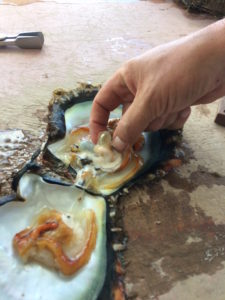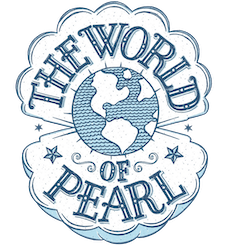Freshwater Black Pearls Do Not Naturally Occur in that Color
File this one under tips for how to shop for pearls! Many times you will find pearl companies selling freshwater black pearls. Now, I have told y’all all about the amazing pearl adventure travels to French Polynesia for black pearls. Freshwater black pearls are not the same as Tahitian black pearls. Freshwater black pearls are simply freshwater pearls that have been dyed black. Here is how we know (without even needing to look at them!)

There are no naturally colored freshwater black pearls! Remember that 98% of the world’s freshwater pearls come from China. It’s important to note that a mollusk can only produce pearls within the range of colors of its own shell. So, Chinese freshwater mollusks have interior shell colors from pink or peach to mauve and white. You will only find natural colored freshwater pearls in that range. There MIGHT be a freshwater black pearl somewhere, someday. But, if you are looking at pearls currently on the market and for sale to all of us, you will not find a naturally colored freshwater black pearl. Or, I feel called to say, you will not find a freshwater pearl whose native color is black. There certainly might be someone dying pearls with “all-natural” dye and calling it a naturally colored black pearl. Right? You never know!

Dyed Freshwater Black Pearls
We know that certain treatments may be done to pearls to enhance their beauty after they have been harvested. This might include anything from cleaning the pearls to heating them in a mild bleach bath to whiten the white pearls. If pearls are dyed, they are subject to the same treatments and then they are simply immersed in dye. Usually, the pearl company will drill the holes in the pearls first and then place them in dye for three to four weeks. Some companies use a simple dye while others use silver nitrate which is a compound produced by dissolving silver in nitric acid. It is water soluble and stable to light. Pearl producers use silver nitrate because with brief exposure it will color pearls purple, brown, or black.
There is room in the market for these colored pearls. First and foremost, a freshwater black pearl will cost significantly less than a saltwater black pearl. They are a great alternative as we save up for the real deal! Plus, colored pearls can be so much fun! Mixing them with colored beads can make some real statement pieces.
These Tahitian black pearl studs pictured above are naturally this color, but they are saltwater pearls! For more info on the differences between saltwater and freshwater pearls, check out this post where I discuss them in greater detail!
There is one more thing to keep in mind. Although some people think that freshwater is synonymous with “not round,” this is simply not true! Sure, many freshwater pearls end up having irregular shapes (they don’t have that beautiful round nucleus like saltwater pearls!). However, there are many absolutely gorgeous, over-the-top beautiful, high quality freshwater pearls. I know because we sell them! Just because you find freshwater black pearls that are round, that doesn’t mean they are something different. These will still fall under the category of a colored pearl, the pearl company simply dyed their round freshwater pearls to the desired color.
I am a modern day treasure hunter who travels the world for gorgeous pearls and amazing adventures. I own a pearl jewelry and jewelry repair business, ThePearlGirls.com, with a cute retail store in Athens, GA. I also have a Pearl Travel business and travel blog at TheWorldofPearl.com.




